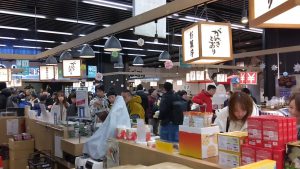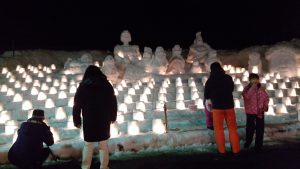2024冬の記憶:残念な2月から盛り返した3月、しかし“雪国の呪い”が・・・/Memories of 2024 winter: March strikes back after shame February, but “Ritual of snow country” came true・・・
2月までの越後湯沢は記録的な小雪、3月に異例の盛り返し
スーパーエルニーニョが昨年現れて、今冬は暖冬になる見通しが色濃かった。それだけに年末から2月に向けては記録的な小雪が続いた。下の写真は本来なら厳冬期にあたる2月の、谷川岳SAと越後湯沢駅前の様子。
Until February, Echigo-Yuzawa experienced record-breaking light snowfall, followed by an unusual resurgence in March
The appearance of Super El Niño last year made it highly likely for this winter to be mild. Consequently, there was a series of record-breaking light snowfalls leading up to February. The photo below shows the conditions in February, which is typically the heart of the winter season, at Tanigawadake SA and in front of Echigo-Yuzawa Station.
(English text continues to the latter half of the page)


そしてこの動画は、関越トンネルを抜けて越後湯沢側に出た瞬間の風景。ちょっと気落ちするくらいに雪が少ない。

これはガーラ湯沢駅から国道17号に下りたところにある電話ボックス、本当に雪の多い年にはこのボックスがそのまま雪に埋まる。どれだけ雪が少ないかが一目瞭然。電話ボックスでスーパーマンのコスチュームに着替えるクラーク・ケントにとっては朗報かもしれないけど・・・
ところが3月に入って、ちょっと例年と様相が変わってきた。

これが実は3/9(土)の朝の光景。3月も中旬に差し掛かった頃に、この量の積雪はあまり見たことがない。自分のスキーシーズンは例年、3月第一土曜日の湯沢雪まつりを以て終了するのだが、今回は少しだけ“おまけ”を楽しめた。
変わる冬の湯沢の光景-インバウンドは台湾の増加が圧倒的
日本各地の有名観光地と同様に、越後湯沢でもインバウンド観光客が急増している。特にコロナ禍が明けた昨年以降、冬の湯沢はインバウンド観光客で一杯、なかでも台湾人が大勢を占めている。もちろん見た目だけでは判断できないものの、近くによると聞きなれたマンダリン(北京語)が聞こえてくる。懇意にしている湯沢のホステルでも冬の間の宿泊客はほぼ全員が台湾で、自分のホームゲレンデのかぐらみつまたスキー場でも半分近くが台湾からの客じゃないかと感じる。台湾人インフルエンサーが相次いで紹介したことに加え、コロナ以前に町を挙げての誘致活動を行っていたのが奏功したこともあるのだろう。
台湾人は大陸から来た中国人と見かけは同じだが、実際に話してみるとわかるのは、まず若者たちは日常会話くらいだったら普通に英語を話す。さすがに専門的な話題になるとついてこられないようだが、これは高校からの教育プログラムによるものだと彼らは主張していた。もっともそこにはメンタルの違いもかなり影響しているようにも思えた。ワーキングホリデーで来ていた20代前半の複数の台湾人と話したが、話題がビジネスや専門分野の方向に行くと途端に専門用語が分からなくなったりするが、むしろそうした時こそますます声を張り上げて主張を強める姿勢がよく見られた。日本の学生だったら、「間違えちゃいけない」と黙り込んでしまうような場面だが、こうしたメンタルの違いも両者の言語能力に大きな差を与えているように感じた。
また彼らは基本的に親日家が多いし、総じて行儀がいい。自分のリゾートマンションに今年から来始めた(大陸からの)中国人家族は、マンションの車出口から出車しようとするといきなり入り口から飛び出してくる、ロビーでは子供が備品を投げ合って傍若無人に暴れ回る、大浴場にカメラを持ち込んで撮影を始める、ごみの捨て方も滅茶苦茶で、誰かが注意しようとしても「日本語は全く分からない」と取り合わない。特定国へのステレオタイプの先入観が醸成されるプロセスを見る思いだが、これに比べると台湾人のほとんどは普通に会話ができてお互いの意図も理解しあえる。見かけが同じだけに、日本の多くの場所では、台湾人も大陸からの中国人も十把一絡げに見られているのか、とちょっと台湾人には気の毒にも思えた。
また台湾人が一斉にbooking.comなどの宿泊予約サイトに殺到するためか、コロナ前に一時増えていたオーストラリアを始めとした白人系のインバウンド観光客は減りつつあるように見えた。

これが平日の越後湯沢駅構内、週末に関係なく急増するインバウンド観光客の中で、もはや平日のスキー旅行は“極楽スキー”ではない。
環境に甘えて努力を怠る越後湯沢は日本の雛型なのか
自分のスキーシーズンは毎年3月初めで終わる。もちろん雪自体は平地のスキー場でも3月末まで、かぐらやガーラのように標高の高いスキー場ではゴールデンウィークまで残っているが、3月になると気温が上がり、雪質が一気に悪くなるため我が家のスキーは3月初めが打ち止めだ(今年はかなりイレギュラーな寒波の到来で、もう少しシーズンが延びたけど)。
我が家のスキーシーズン終了とちょうどタイミングを同じくしていたのが、3月の第一土曜日に開催される「湯沢ゆきまつり」。コロナ前にはこの日には湯沢の温泉街の背後に広がる布場ゲレンデを中心に祭りの屋台や、雪中神輿、雪舞台の上でミュージックライブ、「ミス駒子」のファイナルセレクション、など大々的なイベントが行われた。そして会場の興奮がピークに達する頃に、湯沢高原から100名のスキーヤーがトーチを持って滑り降りてくる松明滑降、そして松明滑降の終盤には平原綾香の「ジュピター」が流れる中で花火が打ちあがる。まさに我が家が冬のシーズンを締めくくるにふさわしいエモーショナルなイベントだった。
『コロナ禍以前の湯沢ゆきまつり』




このイベントが2020年のコロナ禍から中止になった。それはしょうがない話なんだけど、昨年の2023年3月のコロナ明け初のシーズンにはコロナ以前のイベントが再び戻ってくるものと期待していた。ところが復活したのは花火だけで、それも僅か5分間のしょぼいモノ・・・。これにはかなり失望した。今年は花火に加えて松明滑降が復活したものの、これがイベントのすべて、しかも松明滑降が予定よりも速く進み過ぎたらしく途中で10分くらいの中断、さらに松明滑降終了直前から打ちあがるはずの花火が準備不足でこれも10分くらい遅れて始まるなど、段取りが悪いことこのうえない。3年の中断の間にノウハウが失われてしまったのか。
コロナ前まで季節の道標(みちしるべ)となっていた想い出深いイベントがここまで縮小されてしまったのはあまりに残念だ。恐らくは休止中に予算を削られて他部署に持っていかれて、コロナが終わっても従来の予算をそのまま獲得ができないのかもしれない。ただ役所や観光協会筋から漏れ伝わってくる声を聴いていると、
「特に予算を使ってイベントを打たなくても、台湾人も来るようになったし今さら特別にイベントを打たなくてもいいんじゃね」
という本音を感じてしまう。これはかなり危険な兆候!
自分の業務分野である企業分析でも、衰退する企業の典型的なパターンとして、ちょっと環境が好転すると成長のための設備投資を怠るケースが挙げられる。投資を怠ることはその瞬間にはコスト削減かもしれないが、長い眼で見ると確実に成長基盤を危うくする。しかし考えてみると、この傾向は日本経済全体の問題でもある。瞬間的に投資コストを削減して短期的な利益を増やしながら、日本経済は数十年にわたって世界の趨勢に逆らって縮小傾向を続けている。湯沢町はスキーの黄金時代が去ったとは言え、バブル時代に建設された58棟、15,000室に及ぶリゾートマンションから挙がる固定資産税、住民税から他の地域に比べて潤沢な収入があり、本格的な危機に陥ったことがないのが逆に改革を妨げている。ブランド力は地味で気の遠くなるような日常の積み重ねだ。伝統のイベントを簡単に捨ててしまったら、将来に及ぼすマイナス影響は計り知れない。湯沢町にはなんとしても正しい判断に立ち返ってほしい。
伝統の「湯沢ゆきまつり」には大きな懸念を感じるが、その一方で新しく始まった試みもある。冬シーズン中の金・土曜日に複数回開催される「湯沢マルシェ」、越後湯沢駅東口アーケード街の2ブロックにキッチンカーがずらりと並ぶイベントだ。湯沢町観光まちづくり機構が主催しているそうだが、事情通からの情報では「ゆきまつり」とは別のグループがやっているらしい。このイベントも湯沢の新しい伝統的イベントに成長することを心から願う。


『雪国の呪い』?
余談ではあるけど、今シーズンは越後湯沢に滞在するたびに何かを失う、という巡り合わせが続いた。年末年始を含めると同地には計5回滞在したが、ざっとまとめると、
<年末年始>
2024年元旦から能登半島地震の余波で緊急避難、3匹の猫を抱えて右往左往した(過去ポストあり)。今になって思えばこの災難がこれから続く今シーズンの喪失を暗示していたのかもしれない。
<1月中旬>
湯沢に1週間籠ってから、帰路に関越自動車道で跳ね石にあいフロントウインドーにヒビ!任意保険で直すことにするが、保険等級が1段階下がり、これに伴う次年度保険料の追加支払いが14,000円発生。
<1月下旬~2月初め>
越後湯沢に向かう途中、関越自動車道でほぼ20年ぶりに覆面パトカーに捕まる!反則金が15,000円、15年続いたゴールド免許も危うくなるが、とりあえずこれから3か月間無事故無違反なら違反点数2点は消えるということ。ここからは安全運転だあ!
<2月末から3月初め>
今回はなんとか滞在中には何も起こらずに済んだけど、東京に帰ってきてすぐにいつも携帯しているバッグをマンションの部屋に忘れたことに気づき、もう一度マンションに戻らざるを得なくなる。往復で15,000円の負担増。
<3月上旬>
出発前日に突然眼鏡のフレームが壊れてしまい、その修理に30,000円、さらに滞在中にエディバウアーで購入して大事に使っていた高機能パンツのファスナーが壊れてしまう。帰路は安全ピンで塞いでごまかしたが、東京に帰ってきてから修繕に3,000円。
元日にはしっかりと八海山神社に初詣してきたんだけど、この災厄はいったいなんだ!せめて1年分の不運がこれまでに集約されただけと信じたい。
Until February, Echigo-Yuzawa experienced record-breaking light snowfall, followed by an unusual resurgence in March
The appearance of Super El Niño last year made it highly likely for this winter to be mild. Consequently, there was a series of record-breaking light snowfalls leading up to February. The photo below shows the conditions in February, which is typically the heart of the winter season, at Tanigawadake Highway Service Area and in front of Echigo-Yuzawa Station.


And this video captures the scenery the moment you emerge from the Kan-Etsu Highway Tunnel on the Echigo-Yuzawa side. There’s surprisingly little snow, which is a bit disappointing.

This is a telephone booth located just down from Gala Yuzawa Station onto Route 17. In truly snowy years, this booth can be completely buried in snow. It’s clear at a glance just how little snow there is. While it might be good news for Clark Kent to change into his Superman costume in the telephone booth,…
However, as March began, the situation started to change a bit from the usual.

This is actually the scene from the morning of March 9th. By mid-March, it’s rare to see this amount of snow accumulation. Typically, my ski season ends with the Yuzawa Snow Festival on the first Saturday of March, but this time, I was able to enjoy a little extra bonus
The changing winter scenery of Yuzawa – Inbound tourism sees a significant increase from Taiwan
In line with famous tourist destinations across Japan, Yuzawa has also seen a sharp increase in inbound tourism. Particularly since the end of the COVID-19 pandemic last year, winter in Yuzawa has been bustling with inbound tourists, with a significant portion hailing from Taiwan. While appearances alone may not be indicative, it’s common to hear familiar Mandarin (Beijing dialect) nearby. Even in hostels I’m familiar with in Yuzawa, almost all winter guests are from Taiwan, and at my home ski resort, Kagura Mitsumata Ski Resort, nearly half of the visitors seem to be from Taiwan. This surge can be attributed to successive Taiwanese influencers introducing the area and the success of town-wide promotional efforts conducted even before COVID.
While Taiwanese people may visually resemble mainland Chinese, conversing with them reveals differences. Most notably, young Taiwanese individuals can comfortably converse in English for everyday conversation, attributing this ability to their education system starting from high school. However, in discussions involving specialized topics, they might struggle, but instead of retreating, they often assert themselves more assertively. In conversations with several Taiwanese individuals in their early twenties who were on working holidays, I noticed that when the conversation shifted to business or specialized fields, they may not understand technical jargon, but they were more likely to confidently express their opinions, unlike Japanese students who might stay silent for fear of making mistakes. This difference in mentality also seems to have a significant impact on the language proficiency of both groups.
Moreover, they are generally inclined towards Japan and well-mannered. Contrastingly, a Chinese family who recently started coming to my resort condominium this year from mainland China abruptly dashes out from the entrance when trying to exit the parking area, children throw around amenities in the lobby without restraint, take cameras into the communal baths for photography, and dispose of garbage haphazardly, refusing to heed any advice with claims of not understanding Japanese. Observing this process, where stereotypes about specific countries are formed, it’s evident that compared to this, most Taiwanese individuals can engage in normal conversations and understand each other’s intentions. Given their similar appearances, it’s somewhat unfortunate that both Taiwanese and mainland Chinese individuals are sometimes lumped together in many places in Japan, which seems unfair to Taiwanese people.
Additionally, it appears that the influx of Taiwanese people simultaneously booking accommodations through sites like booking.com has led to a decrease in inbound tourists of Caucasian descent, including Australians, who were temporarily increasing before COVID.

This is the scene at Echigo-Yuzawa Station on a weekday, where amidst the rapid increase in inbound tourists regardless of weekends, weekday skiing trips are no longer the ‘paradise skiing’ they used to be.
Is Echigo-Yuzawa, where effort is neglected due to its comfortable environment, a prototype of Japan?
My skiing season always ends in early March. While snow may linger at ski resorts in flatlands until the end of March, and at higher-altitude resorts like Kagura and Gala until Golden Week (consecutive national holidays between end April and beginning May), the rising temperatures in March swiftly deteriorate snow quality, marking the end of skiing for us (although this year, due to irregular cold waves, the season extended a bit longer).
Coinciding with the end of our skiing season is the ‘Yuzawa Snow Festival’ held on the first Saturday of March. Before the pandemic, this day saw grand events like festival stalls, snow shrine processions, live music performances on snow stages, and the final selection of ‘Miss Komako’ centered around the Nunoba ski slope behind Yuzawa’s hot spring town. As the excitement reached its peak, 100 skiers descended with torches from Yuzawa Kogen in the torchlight skiing event, and towards the end, fireworks lit up the sky accompanied by the song of Ayaka Hirahara’s ‘Jupiter’. It was truly an emotional event fitting to close our winter season.
“The ‘Yuzawa Snow Festival before the COVID-19 pandemic.’




The event was canceled in 2020 due to the COVID-19 pandemic, which was understandable, but in March 2023, the first season after COVID, we expected the return of pre-pandemic events. However, only the fireworks returned, and they were disappointing, lasting just five minutes. I was quite disappointed. This year, in addition to the fireworks, the torchlight skiing was revived, but that was the extent of the event. Moreover, the torchlight skiing progressed too quickly, resulting in a 10-minute interruption midway, and the fireworks, which were supposed to start just before the end of the torchlight skiing, were delayed by about 10 minutes due to inadequate preparation. The organization was extremely poor. It seems like they lost their know-how during the three-year hiatus.
It’s so unfortunate that this memorable event, which used to be a seasonal landmark before the pandemic, has been downsized to this extent. Perhaps the budget was cut during the hiatus and diverted to other departments, and even after the pandemic, they couldn’t secure the traditional budget. However, listening to voices leaking from the government offices and tourism associations, I sense the true feelings:
‘With Taiwanese visitors coming even without spending a special budget on events, maybe we don’t need to organize special events anymore.’
This is a very dangerous sign!
In my field of business analysis, a typical pattern for declining companies is when they neglect investment in facilities for growth as soon as the environment shows a slight improvement. Neglecting investment may seem like cost-cutting at the moment, but in the long run, it certainly jeopardizes the foundation for growth. However, upon reflection, this tendency is also a problem for the entire Japanese economy. While momentarily cutting investment costs to increase short-term profits, the Japanese economy has been defying global trends and continuing to shrink for decades. Although Yuzawa Town’s ski golden age has passed, it still generates abundant revenue compared to other regions due to property taxes and resident taxes from the 58 buildings and 15,000 resort condominiums built during the bubble era, which has ironically hindered reform. Brand power is built up through mundane and tedious daily efforts. If traditional events are easily discarded, the negative impact on the future could be immeasurable. I strongly hope that Yuzawa Town will make the right decisions.
While there are significant concerns about the traditional ‘Yuzawa Snow Festival,’ there are also new initiatives underway. One such initiative is the ‘Yuzawa Marche,’ held multiple times on Fridays and Saturdays during the winter season, where food trucks line up in two blocks of the east exit arcade street of Echigo-Yuzawa Station. Although organized by the Yuzawa Town Tourism Development Organization, according to insiders, it is run by a different group from the ‘Snow Festival.’ I sincerely hope that this event will also grow into a new traditional event for Yuzawa.


Curse of the Snow Country?
It seems like I am sharing a series of unfortunate events that occurred during my stays in Echigo Yuzawa this season. Here’s the summary:
- New Year’s Holiday: Emergency evacuation due to the aftermath of the Noto Peninsula earthquake, struggling with three cats(Link). This may have hinted at the losses to come during the season.
- Mid-January: Stayed in Yuzawa for a week, then on the way back, encountered a flying stone on the Kanetsu Expressway, resulting in a crack in the front windshield. The insurance rank dropped, and an additional payment of ¥14,000 for the next term’s insurance premium was incurred.
- Late January to Early February: On the way to Echigo Yuzawa, caught by an unmarked police car on the Kanetsu Expressway for the first time in nearly 20 years! A fine of ¥15,000 was imposed, and the Gold License held for 15 years was in jeopardy. However, if there are no accidents or violations for the next three months, the two penalty points will disappear.
- Late February to Early March: Although nothing happened during this stay, upon returning to Tokyo, realized that the bag usually carried was left in the apartment, necessitating a return trip to the apartment. An additional expense of ¥15,000 for the round trip.
- Early March: The day before departure, the eyeglass frame suddenly broke, costing ¥30,000 for repair. Additionally, the high-performance pants purchased at Eddie Bauer and carefully used during the stay had a broken zipper. Managed to temporarily fix it with a safety pin, but spent ¥3,000 for repair upon returning to Tokyo.
Despite visiting Hakkaisan Shrine for the New Year’s visit, these misfortunes are quite puzzling! I hope that all the misfortune for the year has been concentrated so far.
